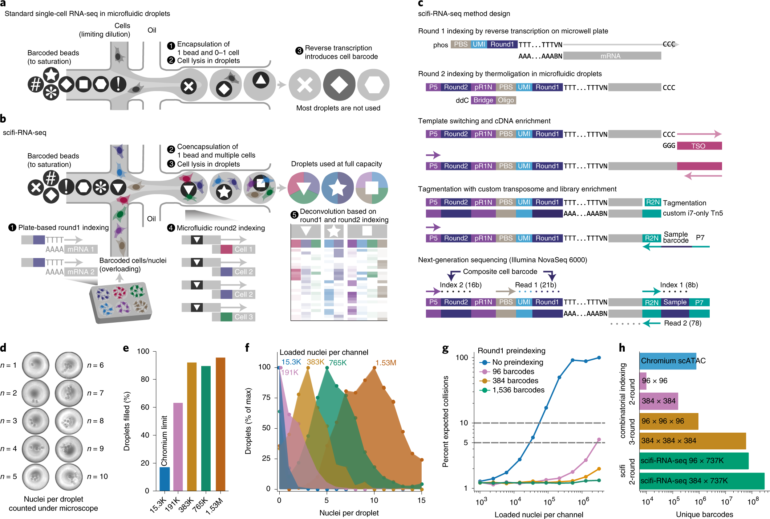The advent of single-cell RNA sequencing (scRNA-seq) has revolutionized the fields of medicine and biology by providing the ability to study the inner workings of thousands of cells at once. But scRNA-seq methods are limited by potential inaccuracies in determining cell composition and inefficient complementary DNA (cDNA) amplification—a process by which a double-stranded DNA that “complements” the single-stranded RNA is generated and replicated millions of times—by the commonly-used template-switching reaction.
Recently, a research team from Japan, led by Assistant Prof. Shigeyuki Shichino and Prof. Kouji Matsushima of Tokyo University of Science, has developed a new and improved technique for scRNA-seq. The new method, terminator-assisted solid-phase cDNA amplification and sequencing (TAS-Seq), uses simple materials and equipment to provide higher-precision scRNA-seq data than the current widely used technologies.
“Our technique, TAS-Seq, combines genetic detection sensitivity, robustness of reaction efficiency, and accuracy of cellular composition to enable us to capture important cellular information,” says Assistant Prof. Shichino. The study was published in Communications Biology on June 27, 2022. The research team also included Associate Prof. Satoshi Ueha of Tokyo University of Science, Prof. Taka-aki Sato of the University of Tsukuba, and Prof. Shinichi Hashimoto of Wakayama Medical University.
TAS-Seq uses a template independent enzyme for cDNA amplification called terminal transferase (TdT). But TdT is difficult to handle. To surmount this challenge, the research team included dideoxynucleotide phosphate (ddNTP) as a “terminator” for the cDNA amplification reaction. “ddNTP spike-in, specifically dideoxycytidine phosphate (ddCTP), stops the excessive extension of polyN-tail by TdT in a stochastic manner, and greatly reduces the technical difficulties of the TdT reaction,” explains Assistant Prof. Shichino.
TAS-Seq also uses a nanowell/bead-based scRNA-seq platform, which allows the isolation of single cells in tissue samples, thereby decreasing cell sampling bias and improving the accuracy of cell composition data. The research team then verified the efficiency of TAS-Seq and compared it to the current, widely used scRNA-seq techniques, 10X Chromium V2 and Smart-seq2, using murine and human lung tissue samples. They found that TAS-Seq could not only detect more genes overall, but also identify more highly variable genes, when compared to major scRNA-seq platforms.
Assistant Prof. Shichino says, “We found that TAS-Seq may outperform 10X Chromium V2 and Smart-seq2 in terms of gene detection sensitivity and gene drop-out rates, indicating that TAS-Seq might be one of the most sensitive high-throughput scRNA methods. We can detect genes across a wide range of expression levels more uniformly and also detect growth factor and interleukin genes more robustly.”
An added advantage of the new method is that TAS-Seq is less susceptible to batch effects. TAS-Seq data was also highly correlated with flow-cytometric data on the tissue samples, indicating that it can generate highly accurate cell composition data.
Speaking of the future, Assistant Prof. Shichino says, “We have already completed development of TAS-Seq2, an improved, extensively-optimized version of TAS-Seq. TAS-Seq2 has 1.5 to 2 times more sensitive gene detection in mouse spleen cells.” The research team has also established ImmunoGenetics, a venture company from Tokyo University of Science, to provide scRNA-seq services using TAS-Seq and TAS-Seq2.
scRNA-seq is an important tool for medical and biology researchers. The development of TAS-Seq and TAS-Seq2 will lead to the discovery of new therapeutic targets for diseases and advancements in the field of “spatial transcriptomics,” which also relies on solid-phase cDNA synthesis. It will also accelerate the development of single-cell omics technology, thereby promoting our understanding of the principles of biology and disease development and progression.
More information:
Shigeyuki Shichino et al, TAS-Seq is a robust and sensitive amplification method for bead-based scRNA-seq, Communications Biology (2022). DOI: 10.1038/s42003-022-03536-0
Provided by
Tokyo University of Science
Citation:
New sensitive and robust single-cell RNA sequencing technique outperforms competition (2022, June 27)



